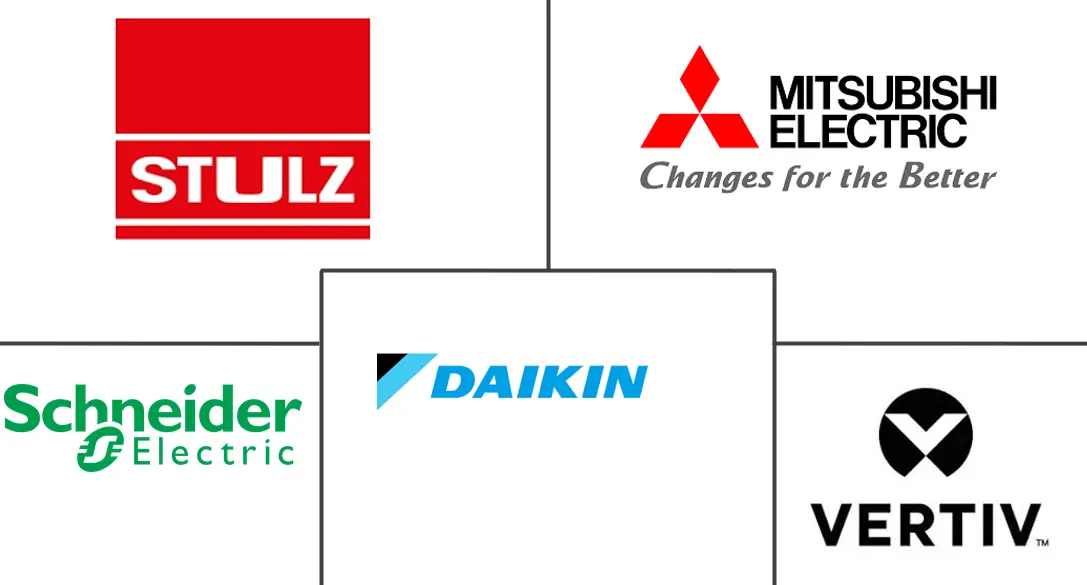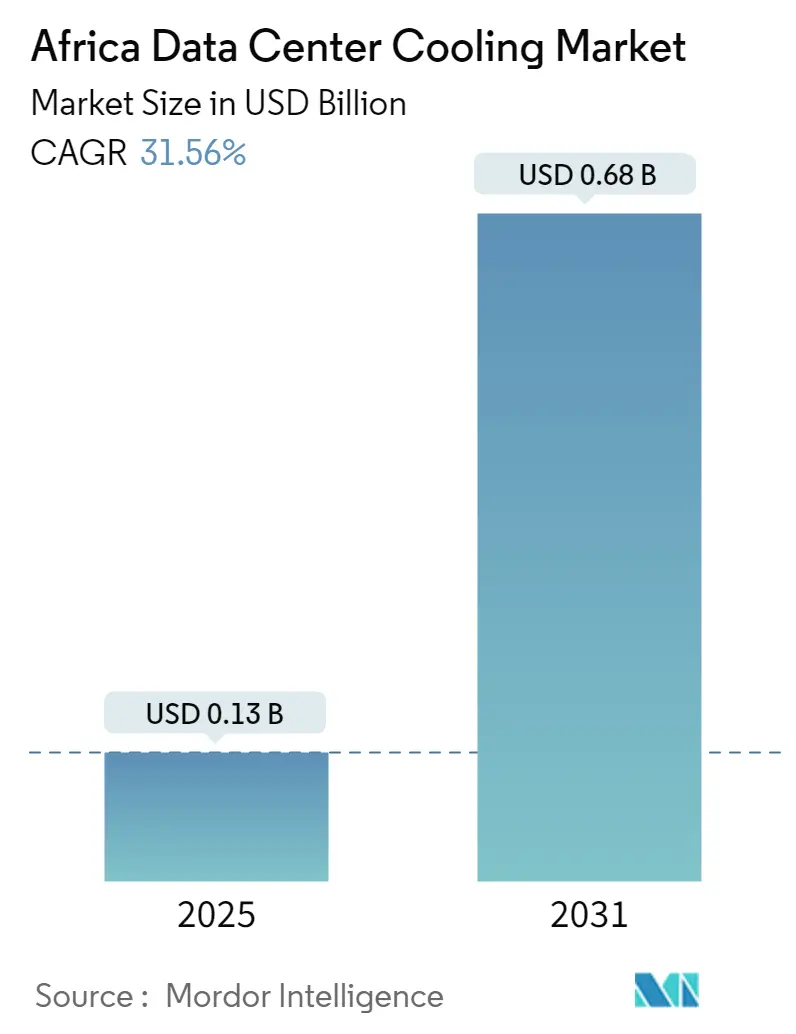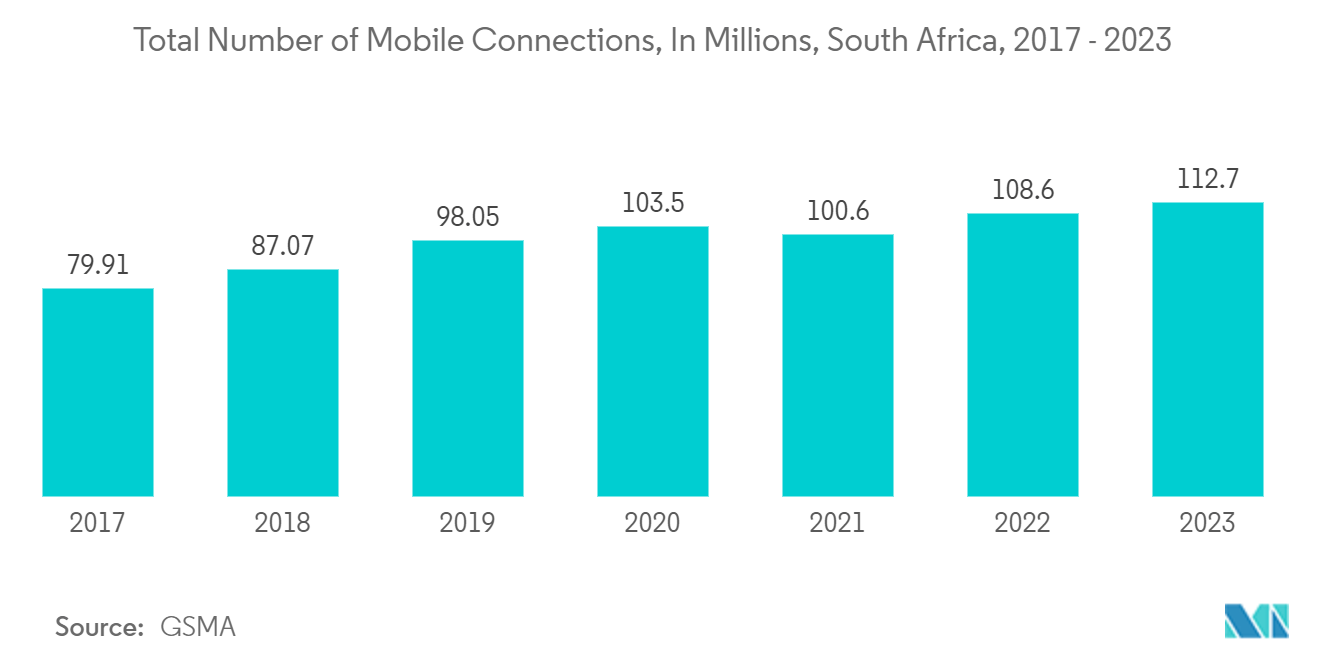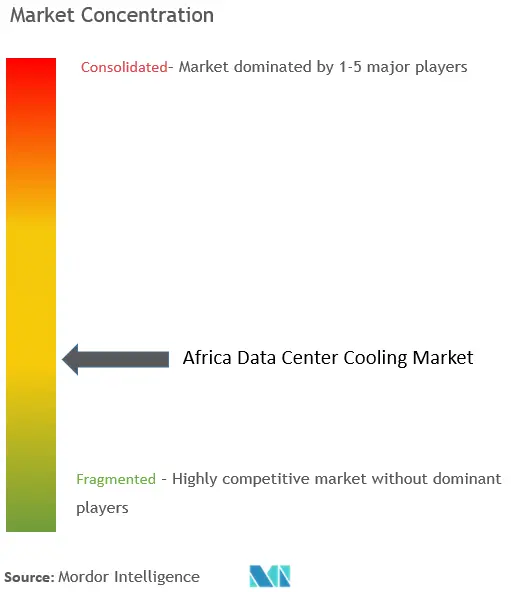Africa Data Center Cooling Market Analysis
The Africa Data Center Cooling Market size is estimated at USD 0.13 billion in 2025, and is expected to reach USD 0.68 billion by 2031, at a CAGR of 31.56% during the forecast period (2025-2031).
The increasing demand for cloud computing among SMEs, government regulations for local data security, and growing investment by domestic players are some of the major factors driving the demand for data centers in Africa.
Under Construction IT Load Capacity: The upcoming IT load capacity of the African data center construction market is expected to reach 3,182 MW by 2030.
Under Construction Raised Floor Space: The region's construction of raised floor area is expected to increase by 11.4 million sq. ft by 2030.
Planned Racks: The region's total number of racks to be installed is expected to reach 570K units by 2030. South Africa is expected to house the maximum number of racks by 2030.
Average temperatures in Africa range from 15°C to 36°C in summer and -2°C to 26°C in winter. Africa's heavy reliance on rain-fed agriculture makes it highly vulnerable to climate variability and change. The choice of cooling technology is typically based on the geographic location of the data center.
Planned Submarine Cables: Close to 70 submarine cable systems connect Africa; many are under construction. One submarine cable expected to begin service in 2024 is Africa-1, spanning over 10,000 km, with a landing point in Port Said, Egypt, and Ras Ghareb, Egypt.
Africa Data Center Cooling Market Trends
IT and Telecom Expected to Witness Highest Growth
- According to the "Measuring Digital Development – ICT Development Index 2024" report released in late June, Libya, Morocco, and the Seychelles lead Africa in ICT development levels. The report evaluates ICT development progress in 170 countries and territories, utilizing 10 key indicators. These indicators encompass metrics such as the percentage of individuals accessing the internet, mobile broadband penetration rates, mobile broadband internet traffic, costs associated with mobile data and voice services, and ownership rates of mobile phones.
- Libya, with a score of 88.1 points, has surged from fifth to first place in just a year, primarily due to notable mobile and internet penetration boosts. Morocco closely trails with a score of 86.8, while the Seychelles secures the third spot with 84.7 points. The top 10 is completed by Mauritius (84.2), South Africa (83.6), Algeria (80.9), Botswana (78.7), Tunisia (77.2), Egypt (76.8), and Gabon (74.7).
- Further, the key telecom players in the region focus on upgrading the network and increasing 5G coverage. For instance, Nigeria has a large number of active mobile connections, with around 2.7 million subscribers using 5G technology, which accounts for 1.24% of the total 219 million connections. MTN Group, a South Africa-based telecom provider, has played a significant role in rolling out 5G services in Nigeria, with several cities including Lagos, Kano, Port Harcourt, Abuja, Ibadan, Maiduguri, and Owerri benefiting from its network upgrade. As a result, coverage has increased from 3% in 2022 to 11% in 2023, contributing to the growth of data centers in the country.
- The adoption of cloud services is propelling the IT industry in Africa. The continent is emerging as a hotspot for cloud investments, driven by the dual imperatives of business expansion and innovation, despite ongoing skills and cost management challenges. Industry titans like AWS, Microsoft Azure, and Google Cloud dominate this landscape. For example, in September 2024, Amazon Web Services (AWS) reaffirmed its commitment to the region by announcing an additional USD 1.7 billion investment, set to be deployed by 2029, to bolster its cloud and artificial intelligence services. Such market moves are poised to amplify the demand for cloud services, subsequently driving the need for data centers and, in turn, heightening the demand for data center cooling solutions.
South Africa Accounts for Largest Market Share
- Johannesburg and Cape Town are the primary hubs for data center growth in South Africa. At the same time, other cities like Centurion, Durban, and Port Elizabeth are anticipated to experience significant expansion in the country's data center market during the forecast period.
- South Africa's strategic position and supportive business environment make it an advantageous location for data center investments. The country's data center market is fueled by the growth of digital technologies like AI and big data, the increasing adoption of cloud services, and the need for huge data storage and processing capabilities. This is evident in the investments made by major cloud providers such as AWS, Google, Microsoft, Huawei, and Oracle. For example, AWS plans to invest USD 1.66 billion in expanding its cloud infrastructure in South Africa by 2029, as announced in April 2023.
- The expansion of digital connectivity is gaining momentum with the development of submarine cables like 2Africa, which is expected to be online in 2024, and T3, which is slated for the end of 2024, significantly decreasing latency. This latency reduction has enabled data center operators to provide customers with faster and more dependable services, sparking investment in the South African data center market.
- In South Africa, the demand for data is rising steadily across various industries. As of January 2023, the country had 43.48 million internet users, with a penetration rate of 72.3%. The growing popularity of e-commerce, particularly in electronics and retail, and the increasing use of social media are driving the growth of colocation services in the country. For example, over the past five years, Netflix has invested over ZAR 2 billion (USD 110 million) in local productions, showcasing over 200 titles.
Africa Data Center Cooling Industry Overview
The African data center cooling market exhibits a moderate level of consolidation among key industry players, having sharpened their competitive edge in recent years. Notable market leaders in this segment include Stulz GmbH, Vertiv Group Corp., Schneider Electric SE, Daikin Industries Ltd, and Mitsubishi Electric Corporation. These industry giants, boasting significant market shares, are actively engaged in expanding their customer base throughout the region. Their growth strategies primarily hinge on strategic collaborative efforts aimed at enhancing market share and overall profitability. Moreover, companies such as Schneider Electric SE, Johnson Controls Inc., and Mitsubishi Electric Europe BV offer liquid and air-based cooling products.
Africa Data Center Cooling Market Leaders
-
Stulz GmbH
-
Vertiv Group Corp.
-
Schneider Electric SE
-
Daikin Industries, Ltd.
-
Mitsubishi Electric Corporation
- *Disclaimer: Major Players sorted in no particular order
Africa Data Center Cooling Market News
- May 2024: Stulz unveiled its latest innovation, the CyberCool Coolant Management and Distribution Unit (CDU), specifically engineered to optimize heat exchange efficiency in liquid cooling solutions. The product line comprises four models, available in two distinct sizes. These units boast an impressive heat exchange capacity, ranging from 345 kW to 1,380 kW. Stulz set the rated water supply temperature for the facility water system at 32°C (89.6°F), with the liquid supply temperature for the technology cooling system pegged at 36°C (96.8°F).
- May 2024: Rittal, in collaboration with multiple hyperscale data center operators, developed a modular cooling system. This solution boasts a cooling capacity exceeding 1 MW, achieved through direct water cooling. It is specifically tailored to cater to the high-power densities of AI applications.
Africa Data Center Cooling Industry Segmentation
Data center cooling is a set of techniques and technologies to maintain optimal operating temperatures in data center environments. Data center cooling is critical as facilities house many computer servers and network equipment that generate heat during operation. Efficient cooling systems are used to dissipate this heat and prevent equipment from overheating, ensuring continued reliable operation of the data center. Various methods, such as air conditioning, liquid cooling, and hot/cold aisle containment, are commonly used to control temperature and humidity in data centers.
The African data center cooling market is segmented into cooling technology (air-based cooling [CRAH, chillers and economizers, and cooling towers] and liquid-based cooling [immersion cooling and direct-to-chip cooling], end-user industry (IT and telecommunication, BFSI, government, and media and entertainment), and country (South Africa, Nigeria, and Rest of Africa). The market sizes and forecasts are provided in terms of value (USD) for all the above segments.
| By Cooling Technology | Air-based Cooling | Chiller and Economizer | |
| CRAH | |||
| Cooling Tower (covers direct, indirect, and two-stage cooling) | |||
| Other Air-based Cooling Technologies | |||
| Liquid-based Cooling | Immersion Cooling | ||
| Direct-to-Chip Cooling | |||
| Rear-Door Heat Exchanger | |||
| By Type | Hyperscalers (owned & Leased) | ||
| Enterprise (On-premise) | |||
| Colocation | |||
| By End-user Industry | IT & Telecom | ||
| Retail & Consumer Goods | |||
| Healthcare | |||
| Media & Entertainment | |||
| Federal & Institutional agencies | |||
| Other End-user Industries | |||
| By Country | Nigeria | ||
| South Africa | |||
| Rest of Africa | |||
Africa Data Center Cooling Market Research FAQs
How big is the Africa Data Center Cooling Market?
The Africa Data Center Cooling Market size is expected to reach USD 0.13 billion in 2025 and grow at a CAGR of 31.56% to reach USD 0.68 billion by 2031.
What is the current Africa Data Center Cooling Market size?
In 2025, the Africa Data Center Cooling Market size is expected to reach USD 0.13 billion.
Who are the key players in Africa Data Center Cooling Market?
Stulz GmbH, Vertiv Group Corp., Schneider Electric SE, Daikin Industries, Ltd. and Mitsubishi Electric Corporation are the major companies operating in the Africa Data Center Cooling Market.
What years does this Africa Data Center Cooling Market cover, and what was the market size in 2024?
In 2024, the Africa Data Center Cooling Market size was estimated at USD 0.09 billion. The report covers the Africa Data Center Cooling Market historical market size for years: 2019, 2020, 2021, 2022, 2023 and 2024. The report also forecasts the Africa Data Center Cooling Market size for years: 2025, 2026, 2027, 2028, 2029, 2030 and 2031.
Africa Data Center Cooling Industry Report
Statistics for the 2025 Africa Data Center Cooling market share, size and revenue growth rate, created by Mordor Intelligence™ Industry Reports. Africa Data Center Cooling analysis includes a market forecast outlook for 2025 to 2031 and historical overview. Get a sample of this industry analysis as a free report PDF download.







